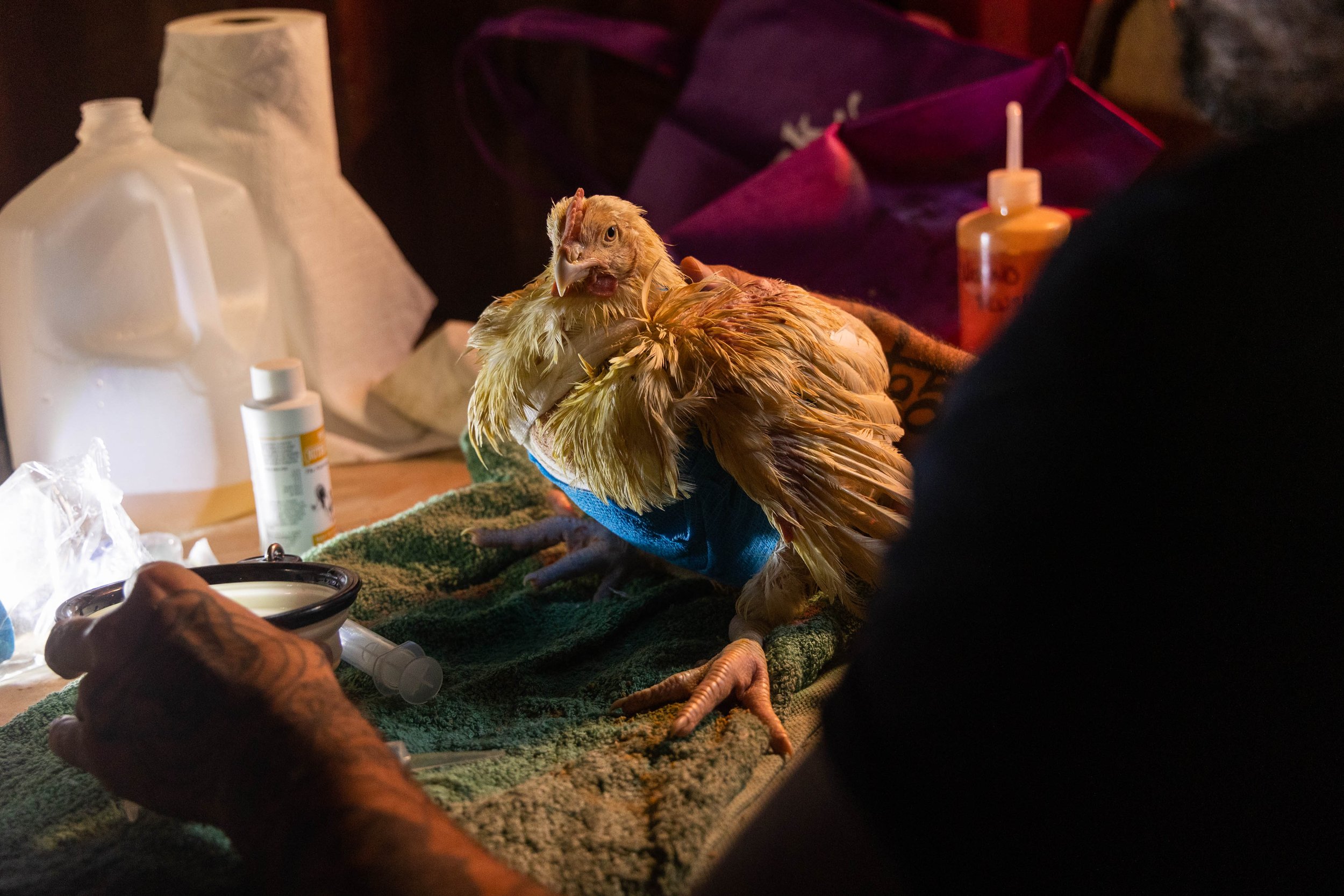Kaporos in the City
Hasidic Jewish men and young boys converge on a public street in Brooklyn on the last morning of Kaporos. Transport trucks filled with empty crates stand parked and ready to take back unused chickens to factory farms, which is where the chickens used in the rituals originate from. Atop the pavement, rain has deteriorated cardboard boxes which lie on the ground mixed with chicken feces and other debris, upon which the people stand and walk about. Kaporos is a religious ritual of atonement where a practitioner swings a chicken by the wings over their head as they recite the prayer. Participants believe this transfers their sins to the chicken, and afterward, the chicken is sent to slaughter. Crown Heights, Brooklyn, New York, USA, 2022. Molly Condit / We Animals
Kapparot, or Kaporos is a ritual practiced by certain sects of orthodox Jews (mainly Chassidic) before Yom Kippur, the Day of Atonement. Traditionally, a live chicken is swung over the head of a practitioner three times while a prayer is recited and the sins of the practitioner are symbolically transferred to the chicken. On the eve of Yom Kippur, the chickens are handed to a shochet (a person certified to kill animals in accordance with shechita law) to be killed and the meat donated to the poor - or eaten at the pre-Yom Kippur meal.
In the week leading up to Yom Kippur, the streets of Brooklyn, New York become one of the largest wet markets in the United States, with an estimated 50,000 to 100,000 chickens being used in the Kapparot ritual and then killed. Those opposed to the practice cite violations to animal welfare laws and public health risks, yet the city of New York allows the practice to continue and assists by providing barricades, floodlights, and NYPD officers stationed at the Kapparot sites as security. In 2022, it rained for four days straight and thousands of chickens were left outdoors in plastic crates with no food or water or protection from the elements. Many were sick and some died in the crates, yet workers and practitioners, including children and the elderly, handled the chickens with bare hands, putting them at risk for contracting bacteria from the birds.
On the morning of Yom Kippur, chickens were slaughtered at a public “pop-up” tent on a public street in Brooklyn - the bodies were left piled nearly two feet high inside a large metal garbage container at the feet of a rabbi performing the slaughter. Some birds were seen dying on blue tarps near transport trucks which were loaded with chickens that were not used for the ritual. The trucks often crushed the bodies of dead birds while attempting to maneuver away from the blocked off street as other chicken corpses were collected by NYC sanitation workers who arrived shortly after daybreak. On assignment for We Animals Media.
A practitioner holds two chickens by their wings, a few feet from a transport truck containing crates. Rain, feces and debris are visible on his and his wife's clothing and their stroller.
An ailing chicken used for the Kaporos religious ritual that takes place annually at various sites in Brooklyn is cradled by an activist at a rescue center.
Rescued chickens used for the Kaporos religious ritual look out from an enclosure at a rescue center. Activists have rescued the chickens from various Kaporos sites in Brooklyn. All the chickens suffer from injuries due to the ritual practice itself, and/or from being over packed into crates left outdoors on the street, exposing the chickens to cold, wet weather.
Chickens rescued from crates at a Kapporot site are wrapped in towels and placed in "hotboxes," cardboard boxes under heat lamps, to raise their body temperature as an activist administers electrolytes.
A rescued chicken used for the Kaporos religious ritual that takes place annually at various sites in Brooklyn is held by an activist at a rescue center. All the rescued chickens suffer from injuries due to the ritual practice itself, and/or from being over packed into crates left outdoors on the street, exposing the chickens to cold, wet weather.
Chickens rescued from crates at a Kapporot site are wrapped in towels and placed in "hotboxes," cardboard boxes under heat lamps, to raise their body temperature.
An activist reveals a chicken suffering from a compound fracture after being used in the Kaporos religious ritual, which involves swinging a chicken by its wings over a practitioner’s head. This handling often results in these kinds of injuries, and more.
A chicken suffering from a compound fracture is given emergency medical treatment by activists and volunteers. He later passed in veterinary hospital.









